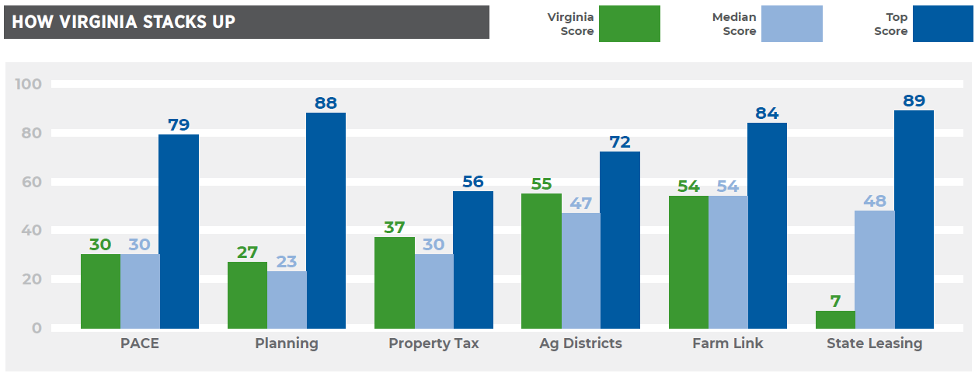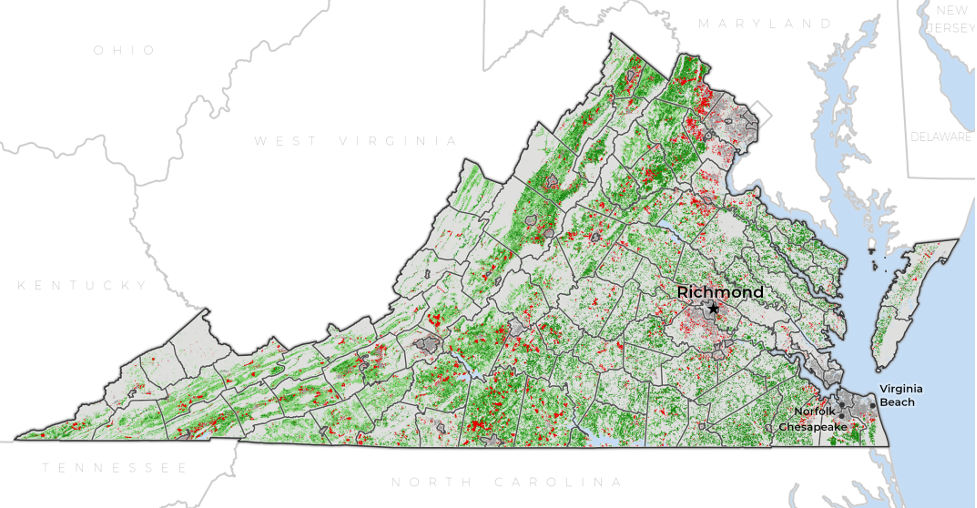PRESERVING FARMLAND THROUGH CLIMATE-SMART AGRICULTURE
Parker Agelasto // Capital Region Land Conservancy //parker@capitalregionland.org
Francesca Costantino // Virginia Association for Biological Farming //labella_francesca@yahoo.com
Michael Kane // Piedmont Environmental Council //mkane@pecva.org
Land & Wildlife Conservation
Executive Summary
Farmland preservation and promotion of high-value organic and climate-smart commodities keep farmland in production, bring prosperity to farming communities, and facilitate agriculture’s contribution as a climate change solution. Farmland managed sustainably with practices like cover crops, vegetated streamside buffers, and no/low-tillage improves soil health with the same benefits as wetlands – improved water quality and wildlife habitat.1 To preserve our farmland, Virginia must embrace smart-growth, permanently protect agricultural land, advance smart solar, enhance farmland access, and create opportunities for the next generation of farmers, particularly the historically marginalized.
Challenge
Agriculture provides food security, recreation, tourism, wildlife habitat, biodiversity, flood mitigation, improved water quality, carbon sequestration, and soil stabilization. Of 8.2 million acres of agricultural land in Virginia, 3.3 million acres (40%) is in the nationally significant category best suited for growing food.
Virginia ranks 7th among US states for most acres of agricultural land to be lost to conversion by 2040.
Virginia’s agricultural land is under threat. Between 2001 and 2016, 340,000 acres of farmland have been developed, 120,000 acres being nationally significant prime farmland soils. Virginia’s conversion threat is higher than its policy response.2 Virginia is 7th and 12th respectively among US States in terms of most acres and largest percent of agricultural land to be lost to conversion by 2040. Rockingham County around Harrisonburg is 5th among US counties in terms of largest percent of agricultural land to be converted; development hotspots around Richmond in Chesterfield County and the I-495 Capital Beltway in Fairfax and Prince William Counties are also at risk. Pittsylvania County stands to lose the most number of acres of agricultural land to development.3

Virginians policy scores compared to the median and the highest scores achieved by all states that have implemented each policy.
Solution
Grass-fed, climate-smart, regenerative,4 and organic production practices provide a premium product and marketing opportunities to capture more value, and allow a farmer to make a livelihood from farming, essential for keeping in pro-duction.5 These same practices build soil health for environmental benefits to water quality and the climate.

Conversion of non-federal farm-land to UHD (Urban and Highly Developed) and LDR (Low-Density Residential) land uses from 2001-2016.
*Farmland is composed of cropland, pastureland, and woodland associated with farms.
**The productivity, versatility, and resiliency (PVR) index targets high-quality agricultural land.
Technical assistance and grants can help small and underserved farms transition to higher value production.
In 2021, the Office of Farmland Preservation (OFP) allocated $270,000 in state matching funds to five local Purchase of Development Rights (PDR) programs, worked with local PDR programs to permanently preserve 152 acres in one easement of working farm and forest lands, and launched a new and improved Virginia Farm Link website at virginiafarmlink.org to connect farm seekers to available land.6 From the start of the program in 1999, Virginia Land Conservation Foundation (VLCF) has funded 40 farmland preservation programs totaling $9,338,622, including 9 projects in 2021 totaling $2,746,876.7
Committed state action is an essential response to farmland loss. Cost and administrative burden of participating in PDR programs for localities must be lowered. Programs to purchase agricultural conservation easements could do more with adequate funding and greater flexibility. The Commonwealth must maintain the successful Land Preservation Tax Credit and continue to regularly issue bonds for state conservation agency land acquisition.
Policy Recommendations
Set a statewide goal for permanent farmland protection and develop a state farmland plan.
$2 million per year to the Virginia Land Conservation Foundation (VLCF) for farmland preservation, $5 million per year to Virginia Farmland Preservation Fund for farmland PDR yearly, and $1 million match per year for federal programs for agricultural and conservation easements.
Lower Purchase of Development Rights (PDR) programs match to 25% and allow nonprofit land trusts to hold easements.
$500,000 yearly through the Office of Farmland Preservation (OFP) for helping frame PDR ordinances for localities and advising on best local zoning practices on preserving farmland in situations of Low-Density Residential land-use.
Establish $10 million small meat processing fund with federal recovery funding.
$250,000 per year for the Agriculture and Forestry Industries Development Fund infrastructure program and $250,000 for technical assistance and grants for a new VDACS program for small and underserved farms to transition to higher value production yearly.
End Notes
1 Lehner, Peter H, and Nathan A Rosenberg. Farming for Our Future: The Science, Law, and Policy of Climate-Neutral Agriculture. Washington, D.C.: Environmental Law Institute, (2021).
2 “Farms Under Threat: Agricultural Land Conversion Highlight Summary Virginia.” American Farmland Trust (2020). https://storage.googleapis.com/csp-fut.appspot.com/reports/spatial/Virginia_spatial.pdf.
3 M. Hunter, A. Sorensen, T. Nogeire-McRae, S. Beck, S. Shutts, R. Murphy. “Farms Under Threat 2040: Choosing an Abundant Future,” American Farmland Trust (2022). https://farmlandinfo.org/wp-content/uploads/sites/2/2022/06/AFT_FUT2040_AbundantFuture-1.pdf.
4 Steward Regenerative Framework defines regenerative. https://public.3.basecamp.com/p/owJPfdu327AUbuqx13DQqpLx.
5 Artem Milinchuk, “Is Regenerative Agriculture Profitable?” Forbes (January 30, 2020). https://www.forbes.com/sitesforbesfinancecouncil/2020/01/30/is-regenerative-agriculture-profitable.
6 “Office of Farmland Preservation Annual Report,” Virginia Department of Agriculture and Consumer Services (December 2, 2021). https://rga.lis.virginia.gov/Published/2021/RD788/PDF.
7 “VLCF Funded Projects,” Virginia Department of Conservation and Recreation, https://www.dcr.virginia.gov/land-conservation/vlcf-grant-list.
